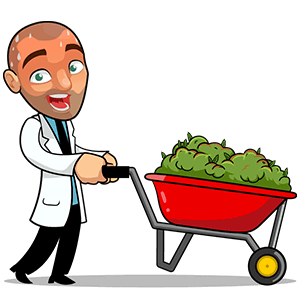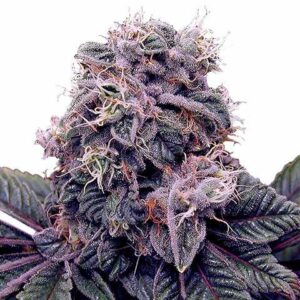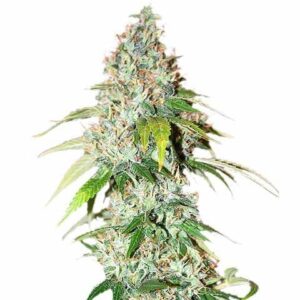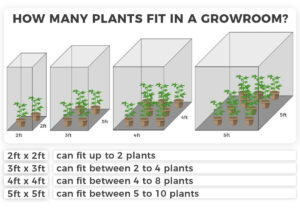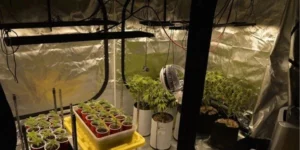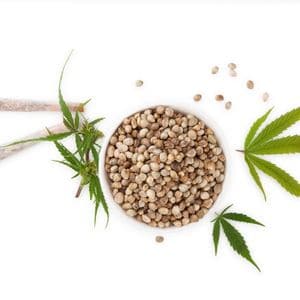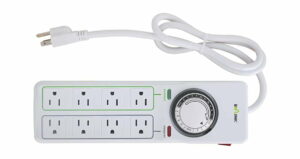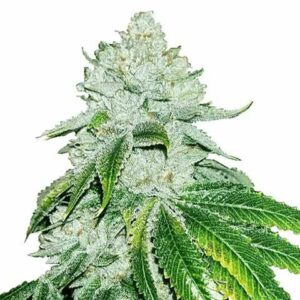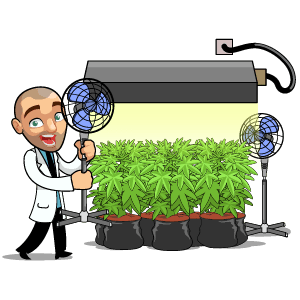The dream cannabis garden is often a wide-open area full of beautiful plants and blue skies. However, most of us are growing plants indoors in tents and wondering exactly how many plants can fit. Several factors contribute to the answer, and we will review those in detail here.
In general, the answer is partially about the quantity of selection, partially about integrated pest management (IPM), and partially related to plant physiology. We’ll detail the important decisions you must make before you start growing.
How to determine the space needed per plant
You can figure out how much space you need from your plant’s morphology. One of the best ways to learn the morphology of the seeds you intend to grow is by checking the breeders’ information. Indica plants tend to be shorter and bushier, with minimal space between the internodes. Sativa plants tend to stretch and grow taller, with more space between the internodes (often needing more vertical space to grow). Autoflowers remain relatively short, even if a sativa cultivar.
Do an internet search for the strain you intend to grow and see if there are grow reports to reference. Regardless of indica or sativa, the amount of vegetative time will influence the number of cannabis plants per tent. If you want multiple strains in your tent, keep plants smaller by using a quicker vegetative cycle. Gardeners who grow less variety but have large plants with bigger yields will often veg longer.
For the average-sized indoor plant, a 2ft x 2ft (61cm x 61cm) designated footprint should give the branches enough space to stretch for the light. The overlapping leaves from neighboring plants will be minimal, and there should be enough remaining open canopy areas for airflow. The two biggest factors for determining the growing space needed per plant will be the genetics and the amount of time you choose to veg for.
What is the recommended grow tent size for beginners?
The natural inclination is to start with a smaller tent, usually 2ft x 2ft (61cm x 61cm). However, controlling the environment in a 2ft x 2ft (61cm x 61cm) tent is multitudes more difficult than controlling the environment in a 4ft x 4ft (122cm x 122cm) tent. The smaller area heats quicker and reaches higher temperatures due to the light source, but it also drops faster when the light goes out.
Humidity levels are increasingly harder to control in smaller tents. Each time a grower waters, extra moisture in the soil raises the relative humidity in the grow tent. You may have heard about vapor pressure deficit (VPD) regarding driving growth. VPD relies on transpiration, which is the release of water from the stomata on the underside of cannabis leaves. More transpiration means more moisture is released into the air.
Smaller grow tents make it more difficult to maintain a balance of environmental conditions. Balance is important with nutrients, watering, and the environment. Large swings, either in temperature or humidity, are to be avoided. For example, Powdery Mildew (PM) can strike low-humidity grows if there are large spikes in humidity. Because of these concerns, our recommended grow tent size for beginners is a 4ft x 4ft (122cm x 122cm) tent.
Below are a few more of our preferred sizes.
- 3ft x 3ft (91.5cm x 91.5cm)
- 2ft x 4ft (61cm x 122cm)
- 4ft x 4ft (122cm x 122cm)
- 5ft x 5ft (152.5cm x 152.5cm)
Is there a difference in grow tent size for autoflowers?
No. Autoflowers typically have the morphology of indica plants, but some can have more upward stretch. The average vegetative time for autoflower varieties is around 30 to 45 days. When growing multiple smaller photoperiod plants in the same tent or grow room, 30 to 45 days of vegetative time is normal. Therefore, there should be roughly the same requirements for tent size with autoflowers.
If you’re looking to grow autoflowering seeds, check out our collection at ILGM!


Buy Autoflower Seeds
- For new and experienced growers
- Easy-growing, low maintenance
- All popular cultivars
How many cannabis plants fit in various-sized grow tents?
The plant counts below are based on a quick vegetative time, aiming to increase the variety of strains in the tent. Every tent size example in this chart can be filled wall to wall with just one plant, given the proper training and a long enough vegetative period. If that is your goal, check out our low-stress training for cannabis tutorial. The numbers below represent the average plant count per tent size.
| Tent size | 2ft x2ft | 2ft x 4ft | 3ft x 3ft | 4ft x 4ft | 5ft x 5ft |
| # of plants | 1-2 | 2-3 | 2-4 | 4-8 | 5-10 |
How big of a tent do I need for X number of cannabis plants?
After selecting new seeds on ILGM, you will know how many plants you want to grow at one time, and you can base your tent size decision on that information as well.
Let’s say you have two that are short and wide but one that likes to grow tall and thin. That scenario may be best for a 2ft x 4ft (61cm x 122cm) tent, whereas two tall thin plants and one wide plant may fit in a 3ft x 3ft (91.5cm x 91.5cm) tent.
We separated the suggestions in this chart by morphology. Short and bushy plants are typical of indica, and tall, slender plants are typical of sativa, but this will vary by strain. We’ve also only listed the maximum recommended in this chart. Although you could physically put more in that space, we’ll explain in a moment why you don’t want to overpack your tent.
| Tent size | 2ft x 2ft | 2ft x 4ft | 3ft x 3ft | 4ft x 4ft | 5ft x 5ft |
| Tall & thin | 2 | 4 | 5 | 9 | 11 |
| Short & wide | 1 | 3 | 2 | 5 | 6 |
| Autoflower | 1 | 3 | 2 | 5 | 6 |
*calculated using a 45-day vegetative period / maximum number of plants / no training
How much yield per plant based on the number of plants per tent
As we have hinted earlier, you can grow one marijuana plant in a 4ft x 4ft (122cm x 122cm) tent or up to eight smaller plants. So which way yields more? The chart below gives rough averages for the expected yields based on the number of plants in a tent. More plants per tent mean less vegetative time and smaller plants, but do the yields stack up?
Another way to look at this metric is in harvests per year. If the larger plant yields more per plant but only allows for half the number of harvests compared to shorter vegging plants, which method yields the most over time? Many variables contribute to yield; to ensure you hit them all, download Robert’s Grow Bible for clear instructions on growing the best dank.
30 to 45 day vegetative cycle:
| Tent size | 2ft x 2ft | 2ft x 4ft | 3ft x 3ft | 4ft x 4ft | 5ft x 5ft |
| # of plants | 2 | 3 | 4 | 6 | 7 |
| Yield per plant | 5-8 oz | 5-8 oz | 5-8 oz | 5-8 oz | 5-8 oz |
| Total yield | 10-16 oz | 15-24 oz | 20-32 oz | 30-48 oz | 35-56 oz |
| Harvests per year | 4 | 4 | 4 | 4 | 4 |
| Annual yield | 40-64 oz | 60-96 oz | 80-128 oz | 120-192 oz | 140-224 oz |
*Harvests per year are based on a 60 day flowering cycle / no plant training
60+ day vegetative cycle:
| Tent size | 2ft x 2ft | 2ft x 4ft | 3ft x 3ft | 4ft x 4ft | 5ft x 5ft |
| # of plants | 1 | 2 | 2 | 4 | 5 |
| Yield per plant | 10-17 oz | 10-17 oz | 10-17 oz | 10-17 oz | 10-17 oz |
| Total yield | 10-17 oz | 20-34 oz | 20-34 oz | 40-68 oz | 50-85 oz |
| Harvests per year | 3 | 3 | 3 | 3 | 3 |
| Annual yield | 30-51 oz | 60-102 oz | 60-102 oz | 120-204 oz | 150-255 oz |
*Harvests per year are based on a 60 day flowering cycle / minimal LST
Why the size and shape of your final plants matter
There are numerous grow methods and plant training techniques. Growers familiar with “sea of green” (SOG) and “screen of green” (SCROG) plant training techniques will know that choosing one or the other will greatly impact the number of mature plants per tent.
SOG setups will pack as many 4-liter containers into a grow tent as possible. The plants are small, and side branches are removed to create a single spear-shaped cola. SCROG is the opposite. Growers use larger pots and spread the top and side branches outward to create a level canopy with multiple tops. SOG plants take up little space; SCROG plants will fill the space.
Cannabis plant training techniques like low-stress training (LST), topping, and fimming can also help shape plants for maximum yield. The more training a grower does, the more time the plant will need in the vegetative stage. Growers should use larger container sizes if they intend to do extensive training. The choice of plant training style will contribute to the answer of how many plants to include.
How much light do I need to install?
The number of plants in a tent can impact this decision, but it is best to gauge lights by the amount of floor space in the grow tent, not the number of plants. The consensus for high-intensity discharge (HID) lighting systems was 50W per square foot (roughly 500W per square meter). With the advancement of LED technology, this number has fallen to approximately 35-40W per square foot (roughly 350-400W per square meter).
Aim to purchase grow lights with a footprint nearly identical to your tent dimensions for even light distribution. When a light is located only over the tent’s center (common for HID systems and quantum board LEDs), the photosynthetic photon flux density (PPFD) will be lower in the tent’s corners than in the center. The most efficient form factor in lighting is currently LED bar-style lighting because of its even light distribution.
| Tent size | 2ft x 2ft | 2ft x 4ft | 3ft x 3ft | 4ft x 4ft | 5ft x 5ft |
| Wattage | 150-200W | 250-300W | 300-400W | 450-600W | 800-1000W |
Want to know how to build a DIY grow tent?, Check out our guide to learn the ropes.
What are the effects of having too many / few plants in the tent?
Having too few plants in the tent is OK; however, your tent may take up more space than needed. You also may be using more power for the lighting than is needed (because tent size, not plant count, should determine power). However, having too few plants in your grow tent will not cause detrimental effects that could reduce yield.
On the other hand, too many plants in the grow tent can be an issue. Cannabis plants, like other plants, experience a phenomenon known as shade avoidance syndrome (SAS). When a plant senses it is being heavily shaded by surrounding foliage, it causes a redistribution of growth hormones. Responses include:
- The main stalk (internodes) and the branches leaves grow from (petioles) become longer
- Altered flowering times
- Less growth energy focused on side branching
Another negative side effect of having too many plants is increased transpiration. In a crowded tent, this extra moisture can become trapped in the thick canopy of leaves and create microclimates. One Integrated Pest Management (IPM) strategy to reduce powdery mildew and botrytis is providing adequate airflow within the canopy. By cramming as many plants as possible into a tent, growers are playing with danger in the eyes of IPM experts.
We’ve created a grow light distance guide for each light source to answer this question.
Final thoughts on grow tent sizes
I always advise people to buy bigger than they need today because growing is fun, and you’ll want to do more. Be realistic with the number of cannabis varieties you want to grow and the expected yields. The temptation to stuff the tent is there; I’ve done it. But by removing some of that volume, I discovered my overall yield actually increased.
Choosing a tent that will allow you to meet your goals for yield per run, or annually if that is how you look at it, is an important step on the road to success. Before starting the grow journey, you’ll need to know what strains you will grow, whether it be a few large plants or a lot of small plants, and how many you can safely fit in a tent. We hope the charts above have answered all the tough questions for you.
Let us know in the comments below if we’ve left out anything. How many plants do you fit in your tent? What is the size of the tent, and how long are you vegging for? We love your feedback. Your contributions help make ILGM the number one resource for excellent grow knowledge and reliable, top-shelf genetics. Happy growing!
- SEO Powered Content & PR Distribution. Get Amplified Today.
- PlatoData.Network Vertical Generative Ai. Empower Yourself. Access Here.
- PlatoAiStream. Web3 Intelligence. Knowledge Amplified. Access Here.
- PlatoESG. Automotive / EVs, Carbon, CleanTech, Energy, Environment, Solar, Waste Management. Access Here.
- BlockOffsets. Modernizing Environmental Offset Ownership. Access Here.
- Source: https://www.ilovegrowingmarijuana.com/growing/how-many-plants-can-you-grow-in-a-grow-tent/
- :has
- :is
- :not
- $UP
- 1
- 30
- 300
- 60
- 91
- a
- About
- above
- actually
- advancement
- advise
- Aiming
- AIR
- All
- allow
- allows
- also
- Although
- always
- amount
- an
- and
- Annually
- answer
- anything
- approximately
- ARE
- AREA
- areas
- around
- AS
- At
- average
- avoided
- Balance
- base
- based
- BE
- beautiful
- because
- become
- before
- Beginners
- being
- below
- BEST
- between
- Big
- bigger
- Biggest
- Blue
- board
- branches
- build
- but
- buy
- by
- CAN
- cannabis
- Canopy
- Cause
- causes
- Center
- Chart
- Charts
- check
- checking
- choice
- Choose
- choosing
- clear
- cola
- collection
- comments
- Common
- compared
- Concerns
- conditions
- Consensus
- Container
- Containers
- contribute
- contributions
- control
- controlling
- corners
- could
- create
- created
- crowded
- Currently
- cycle
- DANGER
- day
- Days
- decision
- decisions
- DEFICIT
- density
- designated
- detail
- Determine
- determining
- difference
- difficult
- dimensions
- discovered
- distance
- distribution
- Diy
- do
- does
- done
- Dont
- download
- dream
- driving
- Drops
- due
- each
- Earlier
- effect
- effects
- efficient
- either
- energy
- enough
- ensure
- Environment
- environmental
- Ether (ETH)
- Even
- Every
- exactly
- example
- excellent
- expected
- experience
- experienced
- experts
- Explain
- extensive
- extra
- Eyes
- factor
- factors
- Fallen
- familiar
- faster
- feedback
- few
- Figure
- fill
- filled
- final
- fit
- Floor
- FLUX
- focused
- Foot
- Footprint
- For
- for yield
- form
- from
- full
- fun
- Garden
- gauge
- General
- Genetics
- Give
- given
- gives
- goal
- Goals
- Goes
- greatly
- Grow
- Grow Reports
- growers
- Growing
- Grows
- Growth
- guide
- Half
- hand
- happy
- harder
- Have
- having
- heard
- heavily
- help
- here
- higher
- Hit
- hope
- How
- However
- HTTPS
- i
- identical
- if
- Impact
- important
- in
- include
- Increase
- increased
- increasingly
- Indoor
- influence
- information
- install
- instructions
- integrated
- intend
- Internet
- into
- issue
- IT
- ITS
- journey
- just
- just one
- Keep
- Know
- knowledge
- known
- large
- larger
- LEARN
- Led
- left
- less
- Level
- levels
- light
- Lighting
- like
- likes
- Listed
- little
- located
- Long
- longer
- Look
- looking
- Lot
- love
- Low
- lower
- Main
- maintain
- make
- management
- many
- marijuana
- mature
- maximum
- May..
- mean
- means
- Meet
- method
- methods
- metric
- minimal
- moment
- more
- most
- much
- multiple
- multitudes
- must
- my
- Natural
- nearly
- Need
- needed
- needing
- negative
- New
- NIH
- no
- normal
- number
- numbers
- numerous
- of
- often
- on
- ONE
- only
- open
- opposite
- or
- Other
- our
- out
- over
- overall
- Pack
- People
- per
- period
- phenomenon
- Physically
- plants
- plato
- Plato Data Intelligence
- PlatoData
- playing
- Popular
- possible
- power
- preferred
- pressure
- proper
- providing
- purchase
- put
- quantity
- Quantum
- question
- Questions
- Quick
- quicker
- raises
- Reaches
- realistic
- recommended
- reduce
- regarding
- Regardless
- related
- relative
- relatively
- release
- released
- reliable
- remain
- remaining
- Removed
- removing
- Reports
- represent
- Requirements
- resource
- responses
- review
- road
- Room
- roughly
- Run
- safely
- same
- SAS
- say
- scenario
- Search
- see
- seeds
- selecting
- selection
- several
- Shape
- Short
- should
- side
- single
- Size
- sizes
- skies
- small
- smaller
- So
- soil
- some
- Source
- Space
- spikes
- spread
- square
- stack
- Stage
- start
- Starting
- Step
- Strains
- Strategy
- strike
- style
- success
- Surrounding
- Swings
- Systems
- Take
- techniques
- Technology
- tent
- than
- that
- The
- Them
- There.
- therefore
- These
- they
- this
- those
- time
- to
- today
- too
- top
- Tops
- tough
- Training
- two
- typical
- typically
- upward
- us
- use
- using
- usually
- variety
- vertical
- volume
- Wall
- want
- was
- Water
- watering
- Waters
- Way..
- ways
- we
- WELL
- What
- What is
- when
- whereas
- whether
- which
- while
- WHO
- why
- wide
- will
- with
- within
- wondering
- X
- year
- Yield
- yields
- you
- Your
- zephyrnet

